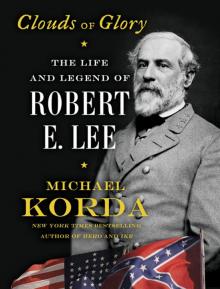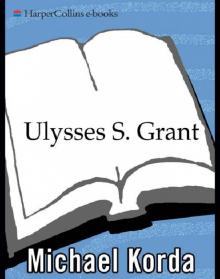- Home
- Michael Korda
Clouds of Glory Page 21
Clouds of Glory Read online
Page 21
After initial doubt that the road could handle the artillery and wagons was resolved by a bold reconnaissance led by Lee, the army proceeded south of the two lakes to San Augustin, a crossroads about ten miles south of Mexico City. Its position was one of extreme danger for the Americans. Reports credited Santa Anna with as many as 35,000 men, and he had had at least four months to build defenses at every approach to the city, and even to cast, from the city’s church bells, large-caliber cannons to replace those he had lost. At this point Scott had just over 12,000 men and was cut off from any possibility of retreat or resupply, and forced to live off the land. What is more, Santa Anna now had the advantage of “interior lines.” Wherever he was attacked on the periphery of Mexico City he could quickly rush reinforcements there. Although Santa Anna was a competent military leader, he lacked Scott’s genius for maneuver and professional skill. He was a formidable organizer and a charismatic figure to his soldiers; indeed his greatest weakness was not in the military sphere: he had no secure footing in the treacherous quicksand of Mexican politics. One reason why the war dragged on is that nobody in Mexico wanted to accept the responsibility for negotiating a peace.
2. The approach to Churubusco.
{Robert E. Lee, Volumes 1, 2, and 3, by Douglas Southall Freeman, copyright © 1934, 1935, by Charles Scribner’s Sons, copyright renewed 1962, 1963, by Inez Godden Freeman. All rights reserved.}
The way ahead from San Augustin was not easily discernible. Scott could not stay there long, since his animals would soon eat up the available forage, and with every hour that went by Santa Anna would further reinforce the city from the south now that he knew the direction from which the American army would attack. A direct advance up the Acapulco road to the hacienda of San Antonio about five miles away from San Augustin was the shortest way to Mexico City, but it presented great risk. San Antonio was heavily fortified and the Americans could not maneuver off the road. On one side there were the broken, razor-sharp rocks of the Pedregal lava field, and on the other side was soft, marshly ground crisscrossed by ditches, in which the guns would surely sink up to their wheel hubs. Scott decided that if he could circle his army around the Pedregal and advance up its west side, along the San Angel road, he would be in a position to come up behind San Antonio. A reconnaissance across the Pedregal, however hazardous, might find a trail or a road, shortening the distance. He sent Worth’s division forward a short way up the Acapulco road to hold the attention of the defenders of San Antonio, and ordered Lee to cross the Pedregal and see what he could find. Lee at once determined that there was a track of sorts around the southern edge of the Pedregal, “passable for infantry and with some work it could be made practicable for artillery.” Then Lee pushed on until he reached an “eminence” known as Zacatapec, where he “encountered a strong Mexican force, which exchanged shots, and withdrew.” Lee and his escort captured five prisoners, and Lee took the opportunity of climbing to the top of Zacatapec. From there he was able to see that the enemy was in a strong position on the San Angel road, near the village of Padierna. Lee concluded that if the Mexicans could cross the southwestern part of the lava field by a rough “mule path,” then the Americans could surely cross it in the opposite direction, and attack the Mexican position from the rear. He returned to San Augustin to report his findings to Scott.
Scott, as was his custom, held a council of war, heard out all his commanders, and then decided in favor of Lee’s suggestion: Lee was to lead a force of pioneers with picks and shovels over the Pedregal to make the path suitable for the artillery. By the afternoon of August 19, Lee had extended the track as far as he could—his pioneers were coming under fire from the Mexican position above the village of Padierna on the San Angel road, which was believed to consist of about 5,000 men and over twenty guns, and assumed to be under the command of General Gabriel Valencia, one of Santa Anna’s better commanders. Again serving as a kind of trailblazer, Lee crossed the Pedregal; found General Twiggs; with Twiggs’s consent, led one regiment of Twiggs’s division forward to drive off the enemy; and then picked a site—on rising ground near the edge of a ravine, and less than thirty yards from the Mexicans—for several batteries of American artillery, one of them commanded by Lieutenant Thomas J. Jackson, who would become famous as “Stonewall” Jackson. Lee stayed with the artillery during a heavy exchange of gunfire, in the course of which the officer standing beside him, the nephew of Lee’s old friend Joe Johnston, lost a leg and shortly afterward died of his wound.
This was, in Nelson’s famous words, “warm work,” in the course of which Lee had plenty of opportunity to demonstrate a steely calmness under fire. Lee’s physical bravery and indifference to danger were by no means unusual—indeed these were the basic requirements of military leadership in the age when lying down or taking cover was unthinkable, since troops had to stand upright in their ranks even under the heaviest fire because it was almost impossible to reload a musket with a ramrod nearly four feet long except while standing, while their officers were expected to lead them into attack, sword drawn, on foot or, still more vulnerably, mounted. Throughout Lee’s military career his total lack of concern for his own safety—even as a famous general in the Civil War, when mounted on Traveller and wearing his famous pearl-gray hat he was at once instantly recognizable and a perfect target—was remarked on with admiration or horrified concern by very brave men indeed. There are, of course, plenty of men in any army who can “screw [their] courage to the sticking-point,” but Lee was not among them—like his father’s, his courage was instinctive, unforced, and natural, and it required no effort of will. He seemed to have no fear at all; nor, as was the case with some men, did courage come at the cost of obliterating rational thought. He was among the first to recognize that a frontal attack against the Mexican position would prove impossible because of the ravine in front of it, which could be “swept” by Mexican gunfire, and to suggest instead using a faint track to the north over the Pedregal that would bring American troops down behind Padierna, crossing the San Angel road, and cutting General Valencia off from any retreat to Mexico City.
Unfortunately, as more and more American troops arrived on the scene a confused frontal attack began, which failed just as Lee expected, as a result of old quarrels and rivalries between General Twiggs and General Pillow, neither of whom apparently paid attention to Napoleon’s famous maxim, “Ordre, contre-ordre, désordre.”* The attacks against General Valencia’s center deteriorated into a bloody stalemate, with small bodies of troops attacking, but no attempt was made to concentrate them for one big attack. Nevertheless, by the afternoon more than 3,000 American troops had crossed the western corner of the Pedregal unseen, thanks to Lee, and were massing half a mile to the north, near the Mexican position around the Indian village of San Geronimo. This area was separated (and concealed) from the left flank of General Valencia’s position by a ravine and a hill, covered with corn and thick underbrush.
It was at this point that a large Mexican force, estimated at as many as 8,000 to 12,000 men, was seen descending the San Angel road less than a mile away from San Geronimo—Santa Anna, hearing the noise of battle on his right from the other side of the Pedregal, had marched the bulk of his forces from their position north of San Antonio around the lava field. It was at once clear that the Americans at San Geronimo might be crushed between General Valencia’s “earthworks” and Santa Anna’s advancing forces. Fortunately night fell, and with it came a violent tropical rainstorm. Even more fortunately for the Americans, Brigadier General Persifor P. Smith, a remarkably steady man, arrived to assume command of the American forces to the west of the Pedregal. Smith was apparently not shaken by the fact that he was surrounded and had fewer than 4,000 troops with which to face the possibility of a combined attack from something between 13,000 and 17,000 men the next day. He summoned Lee, who had scouted the land between San Geronimo and General Valencia’s position and “found it unguarded,” and decided to ignore the large body of Mexican troops to his no
rth and attack General Valencia’s left flank at first light. It would obviously be helpful if the American troops in front of Valencia staged “a strong demonstration in the morning,” but Smith had no way of communicating this to them, so Lee volunteered to ride across the Pedregal by night to the hill of Zacatapec, where he expected to find Scott.
Lee set out at eight o’clock, unable “to observe any of the landmarks,” and guided only by his excellent sense of direction and by occasional lightning flashes. Before climbing onto the black lava wilderness of the Pedregal, he encountered a large body of American troops searching for the way to reach Smith. He sent one of his escort to show them the quickest route to San Geronimo, then proceeded on across the Pedregal, moving through jagged formations of razor-sharp rocks and waiting for lightning flashes to reveal crevasses, so he could work his way around them. When he finally reached Zacatapec, “drenched and sore,” it was only to find that Scott had gone back to San Augustin. Lee did not hesitate—he went on another three miles across the Pedregal; reported to Scott at eleven o’clock; made his way back across the Pedregal in pitch darkness to Zacatapec; explained Smith’s predicament and Scott’s orders; guided American troops to the position where he had stood twenty-four hours earlier; and at dawn led with them into heavy enemy fire at the front of General Valencia’s position, in a “demonstration” intended to mask Smith’s attack. For several minutes men fell all around Lee, as Valencia concentrated his attention on the threat in front of him; then Lee saw Smith’s men charging the Mexican force from their undefended rear, bayonets fixed, and in less than seventeen minutes the whole of General Valencia’s elaborately dug earthworks was overrun, four Mexican generals and twenty guns were captured, 700 Mexican troops were killed, and 800 were taken prisoner—a victory so quick and unexpected that it shook the confidence of Santa Anna’s larger force to the north, which dissolved as the survivors ran back in panic with tales of their defeat.
General Scott hailed Lee’s crossing of the Pedregal as “‘the greatest feat of physical and moral courage’ of the campaign,” but Lee’s services on the battlefield had hardly begun. Despite Scott’s weight and his ponderous manner, the general provided an object lesson in how to follow up a victory quickly. The instant he saw that the Mexicans had been defeated to the west of the Pedregal, Scott withdrew the bulk of his troops to the east and sent them up the Acapulco road to attack San Antonio, while pressing those who remained on the west of the lava field to attack to the north, a well-executed pincer movement carried out despite the exhaustion of the men. He sent Lee on ahead to reconnoiter the road to the north. Lee rode forward and discovered that Santa Anna had abandoned his carefully prepared position at San Antonio and was making a vigorous stand at Churubusco, about two miles north, while most of his disorganized forces retreated into Mexico City. The center of the Mexican position was a heavily fortified convent southwest of the Churubusco canal, protecting a well-planned bridgehead, with a “deep, wet ditch” dug around it, almost like a moat.
Scott decided to attack the Mexican position at once while sending two divisions to attack north of the canal in a flanking movement intended to cut off the enemy’s retreat. He instructed Lee, who had ridden ahead and examined the position carefully, to lead the two divisions and select a position for them, despite the fact that Lee was a mere captain of engineers. Lee himself described the action that followed in a letter to Mary: “Discovering a large mass of infantry on the Churubusco bridge, and apprehending a fire from batteries to defend the rear, I drew out towards the City of Mexico until I reached a hamlet on the Mexican road about three fourths of a mile in the rear of the bridge.” There was “a mass” of cavalry on the road, and as the American troops “formed a line” at an oblique angle to the road, the Mexicans pushed their own line farther to their right in order not to be outflanked. “Our troops being now hotly engaged and somewhat pressed,” Lee wrote, “I urged forward the Howitzer battery . . . [which] very promptly brought the pieces to bear upon the head of the column with good effect.”
Still, the Americans were “greatly outnumbered,” so Lee rode back to Scott to ask for reinforcements. He led them back to where the fight was hottest, but owing to the boggy ground they still could not outflank the Mexicans, and there was nothing for it except “a frontal attack on the road,” in which Lee took part under constant heavy fire. Just as the Americans reached the road, the troops to the south of the Churubusco canal carried the convent and the bridgehead, and the enemy broke, the survivors retreating to Mexico City. The fight at the fortified convent had been particularly bloody, for it was defended by the 204 remaining members of the “San Patricio (St. Patrick) Battalion,” consisting of deserters from the U.S. Army, the bulk of them Irish Catholic immigrants who felt they had been bullied and persecuted because of their religion, and who expected no mercy if they surrendered or were captured. Nor did they receive any: fifty who survived the fierce hand-to-hand fighting inside the convent were hanged, including one who had lost both legs and was carried in a wheelbarrow from his hospital bed to the gallows.
Lee had been on foot or mounted for more than thirty-six hours without rest, had crossed the Pedregal three times, and had fought in three battles. His superiors, in agreement for once about something, joined in praising his “skill . . . and personal daring” (Smith), his “valuable services” (Twiggs), his “skill and judgment” (Shields). Scott added that Lee was “as distinguished for felicitous execution as for science and daring.” He would receive a promotion to brevet lieutenant colonel. No other officer in the Mexican War received such universal praise, or won such widespread admiration. The Lee legend began at Churubusco and would carry Lee to the very highest degree of military fame—though not, of course, in a way he could have foretold. In addition, his close relationship with the normally unapproachable general in chief gave him a rare insight into the demands of commanding an army unusual for an officer of his rank.
Despite a succession of victories Scott momentarily hesitated to attack Mexico City. He had lost over 1,000 men, in the past few days of battle, but even though one impetuous American cavalry officer rode all the way to the San Antonio gate, the southernmost of the fortified gatehouses in the city wall (and lost an arm for his pains), Scott did not see how he could take and hold a city of nearly a quarter of a million people with his depleted and exhausted forces. Scott had never believed that the object of his campaign was to take and occupy Mexico City; rather, the object was to force the Mexicans to sign a peace treaty acknowledging the permanent loss of nearly a third of their national territory. When they unexpectedly asked for an armistice a few days after their defeat at Churubusco, Scott was happy enough to agree, believing that it was the first step to peace.
The general made his headquarters at Tacubaya, “a pleasant village where numerous wealthy members of the English colony in Mexico City maintained summer homes,” while the negotiators wrangled interminably over the proposed treaty until it became clear after twelve days that no formula could be found that would satisfy President Polk and the Mexican government. Hostilities resumed on September 7. Scott was criticized by many of his own soldiers (and by future historians) for this delay, but they underestimated Scott’s losses, as well as the fact that he was now 280 miles from his base, with no reliable means of communication or supply, and above all his belief that his mission was “to conquer a peace.” Lee, who was certainly as close as anyone to the general in chief, did not disagree with him.
The peculiar geography of Mexico City created a unique problem for any attacker. In those days the city itself was “on slightly elevated ground,” and surrounded by marshy fields. The only approaches to the capital were along raised, straight, narrow causeways. Advancing along any one of them would put the troops into the position of ducks in a shooting gallery, in addition to exposing them to cross fire from the fortified city gates. The American army was placed so that its most convenient approach to the city was along the three causeways that ran from so
uth to north. The two causeways that approached the city from the southwest and the west posed the further difficulty that they were dominated by a steep hill 220 feet high less than two miles from Scott’s headquarters. Once a sacred place for the Aztecs, the hill was topped by a massive “neo-romantic” castle that had been transformed into the Mexican military academy. Approached by a road that zigzagged up a sheer cliff, and surrounded at its base by a high stone wall, Chapultepec looked like a formidable obstacle, which the Mexicans were almost certain to defend with particular zeal because of its symbolic significance.
Before Scott decided on the best way to take Mexico City he determined to attack Molino del Rey, a stout stone building near the base of Chapultepec, where he had been informed that Santa Anna was casting bronze cannons. He wished to have Worth’s division make a night attack on it, but after a stormy scene Lee managed to change Scott’s mind. The attack began at daylight on September 8, but the result was disappointing. Worth attacked without sufficient artillery preparation; took the building, where there was no evidence of a cannon foundry; and was nearly forced back by a Mexican counterattack, which led to almost 800 American casualties in some of the heaviest fighting of the war. Since the Americans kept the building, they could claim a victory, but it was something of a Pyrrhic one, and a warning that the Mexican army, now that it was literally at the gates of its own capital, could still fight with remarkable bravery.

 Passing
Passing Another Life
Another Life Clouds of Glory
Clouds of Glory Hero: The Life and Legend of Lawrence of Arabia
Hero: The Life and Legend of Lawrence of Arabia Cat People
Cat People Hero
Hero With Wings Like Eagles: A History of the Battle of Britain
With Wings Like Eagles: A History of the Battle of Britain Ulysses S. Grant
Ulysses S. Grant